
Acrylic paint is a fast-drying paint made of pigment suspended in acrylic polymer emulsion and plasticizers, silicone oils, defoamers, stabilizers, or metal soaps. Most acrylic paints are water-based, but become water-resistant when dry. Depending on how much the paint is diluted with water, or modified with acrylic gels, mediums, or pastes, the finished acrylic painting can resemble a watercolor, a gouache, or an oil painting, or have its own unique characteristics not attainable with other media and are meant for canvases.

Oil painting is a painting method involving the procedure of painting with pigments with a medium of drying oil as the binder. It has been the most common technique for artistic painting on canvas, wood panel or copper for several centuries, spreading from Europe to the rest of the world. The advantages of oil for painting images include "greater flexibility, richer and denser colour, the use of layers, and a wider range from light to dark". But the process is slower, especially when one layer of paint needs to be allowed to dry before another is applied.

A pastel is an art medium that consist of powdered pigment and a binder. It can exist in a variety of forms, including a stick, a square, a pebble, or a pan of color, though other forms are possible. The pigments used in pastels are similar to those used to produce some other colored visual arts media, such as oil paints; the binder is of a neutral hue and low saturation. The color effect of pastels is closer to the natural dry pigments than that of any other process.

Gesso, also known as "glue gesso" or "Italian gesso", is a white paint mixture used to coat rigid surfaces such as wooden painting panels or masonite as a permanent absorbent primer substrate for painting. It consists of a binder mixed with chalk, gypsum, pigment, or any combination of these.
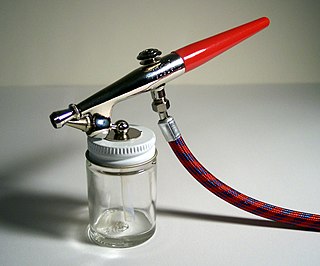
An airbrush is a small, air-operated tool that atomizes and sprays various media, most often paint, but also ink, dye, and foundation. Spray painting developed from the airbrush and is considered to employ a type of airbrush.
Water-miscible oil paint is oil paint either engineered or to which an emulsifier has been added, allowing it to be thinned and cleaned up with water. These paints make it possible to avoid using, or at least reduce volatile organic compounds such as turpentine that may be harmful if inhaled. Water-miscible oil paint can be mixed and applied using the same techniques as traditional oil-based paint, but while still wet it can be removed from brushes, palettes, and rags with ordinary soap and water. One of the ways its water solubility comes from is the use of an oil medium in which one end of the molecule has been engineered to be hydrophilic and thus bind loosely to water molecules, as in a solution. This type of paint is different to those that are engineered to enable cleaning of brushes and application equipment in water but are not in themselves water reducible.

A kitchen knife is any knife that is intended to be used in food preparation. While much of this work can be accomplished with a few general-purpose knives – notably a large chef's knife, a tough cleaver, a small paring knife and some sort of serrated blade – there are also many specialized knives that are designed for specific tasks. Kitchen knives can be made from several different materials.

Aerosol paint is paint that comes in a sealed, pressurized container and is released in an aerosol spray when a valve button is depressed. The propellant is what the container of pressurized gas is called. When the pressure holding the gas is released through the valve, the aerosol paint releases as a fine spray. Aerosol painting is one form of spray painting; it leaves a smooth, even coat, unlike many traditional rolled and brushed paints. Aerosol primer can be applied directly to bare metal and many plastics.
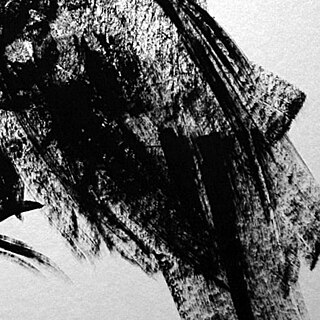
Drybrush is a painting technique in which a paint brush that is relatively dry, but still holds paint, is used to create a drawing or painting. Load is applied to a dry support such as paper or primed canvas. The resulting brush strokes have a characteristic scratchy and textured look that lacks the smooth appearance that washes or blended paint commonly have. This technique can be used to achieve a blurred or soft appearance.
A glaze is a thin transparent or semi-transparent layer on a painting which modifies the appearance of the underlying paint layer. Glazes can change the chroma, value, hue and texture of a surface. Glazes consist of a great amount of binding medium in relation to a very small amount of pigment. Drying time will depend on the amount and type of paint medium used in the glaze. The medium, base, or vehicle is the mixture to which the dry pigment is added. Different media can increase or decrease the rate at which oil paints dry.
Corel Painter Essentials is a home software studio for turning photographs into paintings. Corel Painter Essentials is now in its 7th incarnation.
Acrylic painting techniques are different styles of manipulating and working with polymer-based acrylic paints. Acrylics differ from oil paints in that they have shorter drying times and are soluble in water. These types of paint eliminate the need for turpentine and gesso, and can be applied directly onto canvas. Aside from painting with concentrated color paints, acrylics can also be watered down to a consistency that can be poured or used for glazes.

Painting is a visual art, which is characterized by the practice of applying paint, pigment, color or other medium to a solid surface. The medium is commonly applied to the base with a brush, but other implements, such as knives, sponges, and airbrushes, can be used.

A palette is a surface on which a painter arranges and mixes paints. A palette is made of materials such as wood, paper, glass, ceramic or plastic, and can vary greatly in size and shape. Watercolor palettes are generally made of plastic or porcelain in a rectangular or wheel format, and have built in wells and mixing areas for colors. For acrylic painting, "stay wet" palettes exist, which prevent the paints from drying out and becoming inert.
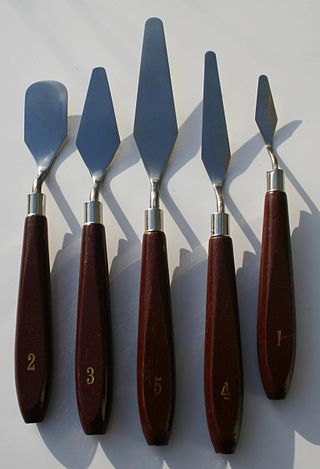
A painting knife is an artist's tool with a flexible steel blade used to apply and manipulate paint directly on the canvas. They are manufactured in a variety of styles and sizes. Blades can be long and thin, triangular, rectangular or diamond shaped. Handles are either straight or offset like a trowel.
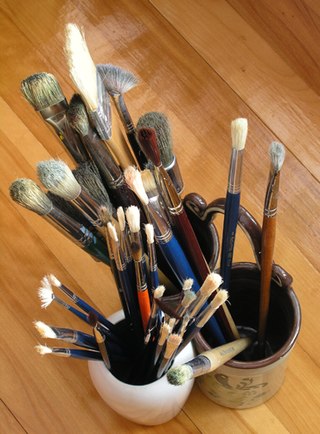
A paintbrush is a brush used to apply paint or ink. A paintbrush is usually made by clamping bristles to a handle with a ferrule. They are available in various sizes, shapes, and materials. Thicker ones are used for filling in, and thinner ones are used for details. They may be subdivided into decorators' brushes used for painting and decorating and artists' brushes use for visual art.
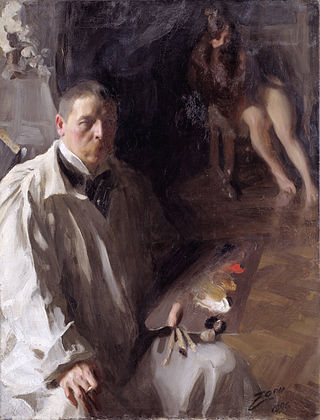
Paint mixing is the practice of mixing components or colors of paint to combine them into a working material and achieve a desired hue. The components that go into paint mixing depend on the function of the product sought to be produced. For example, a painter of portraits or scenery on a canvas may be seeking delicate hues and subtle gradiations, while the painter of a house may be more concerned with durability and consistency of colors in paints presented to customers, and the painter of a bridge or a ship may have the weatherability of the paint as their primary concern.

Beware of Luxury is a 1663 oil painting by the Dutch painter Jan Steen, now in the Kunsthistorisches Museum in Vienna.
Erin Hanson is an Oregon-based artist, considered to be the originator of painting style called "Open Impressionism." Her landscape paintings have been shown internationally and at solo and group exhibitions and museums worldwide.













